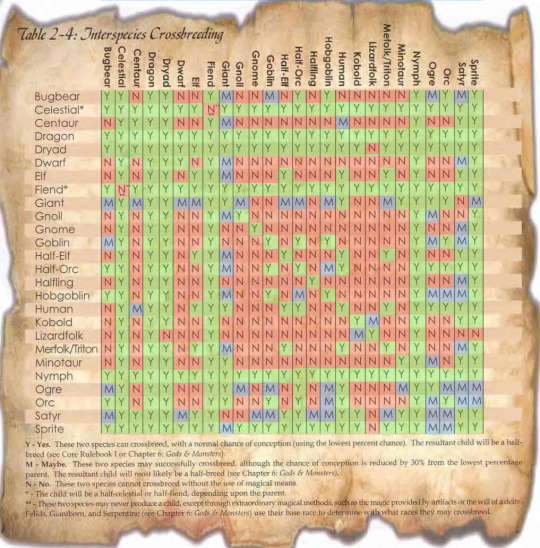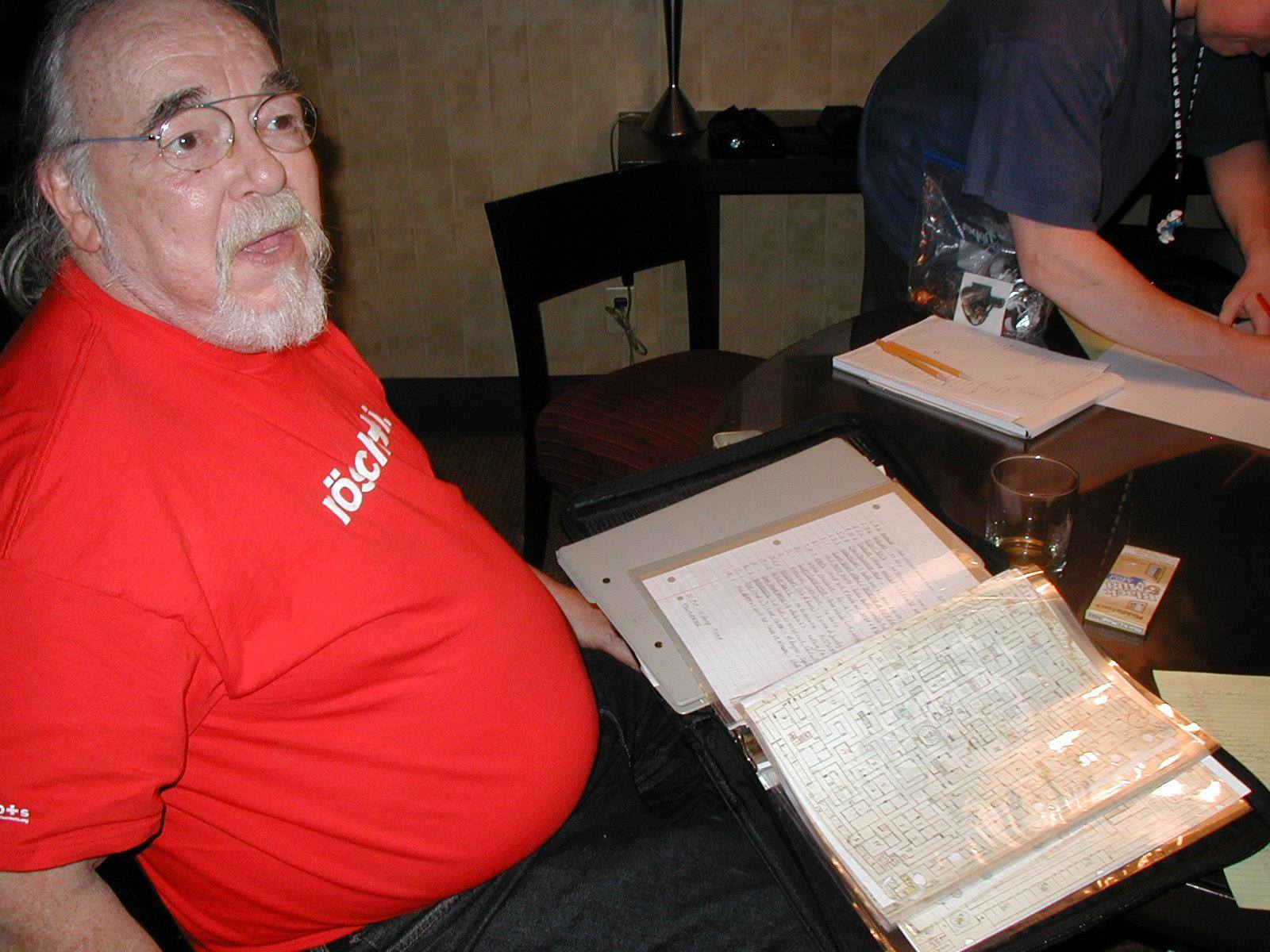HUMANS && HYBRIDS
THE
HALF-OGRE,
S
M I T I N G H I M H I P A N D
T H I G H
| - | - | The Half-Ogre (Revised) | - | - |
| Dragon 29 | - | Best of Dragon, Vol. II | - | Dragon |
Of late I have seen several
different treatments of half-ogres, and the
suggestion that this type
of creature is a viable and worthwhile racial
type for player characters
has thus gained some small popularity. This
subject also touches upon
another, closely related matter, the whole
gamut of cross breeds which
could possibly be included in AD&D.
Dungeon Masters must be
apprised of the potential can of worms they
will be opening by allowing
these mixtures in their campaigns.
The character races in AD&D
were selected with care. They give
variety of approach, but
any player selecting a non-human (part- or
demi-human) character does
not have any real advantage. True, some
of these racial types give
short term advantages to the players who
choose them, but in the
long run these same characters are at an equal
disadvantage when compared
to human characters with the same
number of experience points.
This was, in fact, designed into the game.
The variety of approach
makes role selection more interesting. Players
must weigh advantages and
disadvantages carefully before opting for
character race, human or
otherwise. It is in vogue in some campaigns to
remove restrictions on demi-humans—or
to at least relax them somewhat. While this might make the DM popular for
a time with those
participants with dwarven
fighters of high level, or elven wizards of vast
power, it will eventually
consign the campaign as a whole to one in
which the only races will
be non-human. Dwarves, elves, etal. will have
all the advantages and no
real disadvantages, so the majority of players
will select these races,
and humankind will disappear from the realm of
player character types.
This bears upon various hybrid racial types as
well.
In designing ADVANCED
DUNGEONS & DRAGONS, I considered
the possible racial mixtures.
Should half-dwarves, half-gnomes, and
half-halflings (and is a
half-halfling a quartling, perchance?) be allowed?
How about dwarf-elf, dwarf-gnome,
dwarf-halfling, elf-gnome, elf-halfling, and gnome-halfling crossbreeds?
Then there are tri-racial mixtures.
Those involving humans and
orcs add still more confounding factors.
And now somebody decided
that ogres could cross with humans! Could
they cross with elves also?
How about hill giants interbreeding with
humans? with elves? with
ogres? with ettins? Why leave out goblins?
hobgoblins? gnolls? bugbears?
Because of the potential
for absolute
madness in the game, I included
only the half-elf, hoping that the rest
would not arise to plague
the placid waters of racial selection, but it is
apparent that it was not
meant to be.
Consider the various factors
which must be taken into account when
designing a race for game
purposes. Remember that last part, game
purposes; AD&D is, first
and foremost, a game. Races, just as with
classes, must be in relative
balance with each other, as well as with the
game as a whole. Setting
this balance is a difficult and delicate operation! So we have 1) character
class limits due to race, 2) level limits due
to race, 3) ability adjustments
due to race, 4) racial minimums and
maximums of abilities, 5)
racial preferences, and 6) special characteristics of racial types, i.e.
magic resistance, saving throws, combat versus
specific monsters, visual
and other sense capabilities, and “sixth-sense”
or innate skill capabilities
(such as detection of grades, and underground
conditions, etc.). If these
six factors are considered only as single entities,
not as multi-faceted ones,
there is still plenty of work to do in setting up
even a single additional
character race, for each must be meshed with
and balanced against all
other such races. Now consider the possible
cross breeds, and multiply
your DMing woes by a thousand! As surely as
you allow a single player
to select a non-standard hybrid, another will
come along asking for some
special cross breed which he or she
envisions to be “logical”,
meaningful, and fun to play (read advantageous for the player in question!).
Pixie-storm giant half-breeds would
not be impossible . . .
. (For those who doubt the last claim, consider a
lecherous male pixie equipped
with several growth potions and a love
philtre. And, when all is
said and done, AD&D is fantasy.)
H A L F - O G R E
Character Classes Possible:
cleric or fighter
Class Level Limits: cleric 4th; fighter unlimited
Ability Adjustments:
STRENGTH — 14 - 18a
INTELLIGENCE — 3 - 12b
WISDOM — 2 - 12c DEXTERITY
— 3 - 12d
CONSTITUTION — 14 - 18e
CHARISMA — 2 - 8f
aAverage human strength
combined with ogre strength
and averaged to find spread.
Use d6 and 5 or 6 equals 18,
with a percentile bonus
of 25% to the roll if a 6, but 18/00
maximum in any event.
bThis spread could be lowered
to a 10 maximum if the
human parent was below norm.
cThis spread could be lowered
to a 10 maximum if the
human parent was below norm.
dAgain, this is generous,
and a case could be made for 3-10
(d8 +2).
eConstitution roll in excess
of 18 is not possible, and if the
d6 roll is 6, then treat
it as the 18 maximum.
fCharisma score would not
apply to ogres and half-ogres;
double the result for the
charismatic effect on such
creatures.
Racial Preferences:
Half-orcs would rate a T,
humans an N,
and half-ogres a P.
All others would be H both
ways.
Special Characteristics:
Infravision to 60’.
Speak ogre, orc and troll
only if raised with ogre parent.
Complexion will be swarthy
and dull, hair lank and dark.
Average height will be 7½’.
Two hit dice at 1st level,
then
regular progression as usual.
These quite reasonable parameters
for half-ogre character typify
the offspring of a human
and an ogre, were there such a thing as the
latter, define their potential,
and make it a race which will not disrupt the
campaign. The only advantages
accruing to half-ogres are in strength
and constitution, and these
are more than outweighed by disadvantages elsewhere. In fact, this race,
when properly controlled, becomes a
rather unappetizing and
boring prospect for character play. On the
other hand, such creatures
would make highly desirable guards or
mercenary troops—assuming
one could abide their chaotic and evil
bent—for they have many
benefits and few drawbacks when compared
with full-blooded ogres.
For this reason alone, there will have to be strict
limits placed upon the numbers
of half-ogres available in the campaign.
It is important to reiterate
that hybrids not shown in PLAYERS
HANDBOOK
should be generally rejected in the well-run campaign.
The device is that of players
seeking to gain some advantage for
themselves by choosing a
racial mixture which they believe will have
greater advantages (with
fewer drawbacks) than those of the character
races given in AD&D.
If exceptions are to be made, be certain that you,
the DM, consider each thoroughly
prior to admitting it into the milieu.
Each exception must be detailed
as was done for the half-ogre, above.
Do so privately, and if
after listing its parameters you find that the hybrid
is unacceptable, disallow
its use—or go back and restructure the characteristics, being careful to
use the examples of the PLAYERS HANDBOOK as a guide.
Then, and only then, should
a player be allowed to
have such a hybrid racial
type to choose from. Lastly, if thereafter many
of your participants suddenly
express a desire to start characters of this
particular racial mixture,
you can pretty well rely upon the fact that you
blew it.

All of this will certainly
lead to the question, why is it that the human
race is so favored in AD&D?
There is no question that human characters
have an edge on all others
in the long run—even considering the
generally unlimited potential
for non-human thieves. The bias was
placed in the game on the
assumption that the vast majority of campaign
milieux would be based on
human-dominated worlds. Therefore, humans must have some sort of edge.
As human adaptability is
undoubted, and human capabilities deemed vast by this writer, it seemed
to follow that allowing
them the full range of possibilities was the best
answer. Thus, humans are
found in all alignments, in all professions,
and so on. The weakest are
very weak, the strongest very strong. The
human race plumbs the depths
and soars to the heights. In AD&D, as in
the real world, humankind
will certainly attain greatness and domination if it doesn’t destroy itself
first through warfare and strife within its
own race.
